check engine light MERCEDES-BENZ B-CLASS 2012 Owners Manual
[x] Cancel search | Manufacturer: MERCEDES-BENZ, Model Year: 2012, Model line: B-CLASS, Model: MERCEDES-BENZ B-CLASS 2012Pages: 340, PDF Size: 3.09 MB
Page 7 of 340
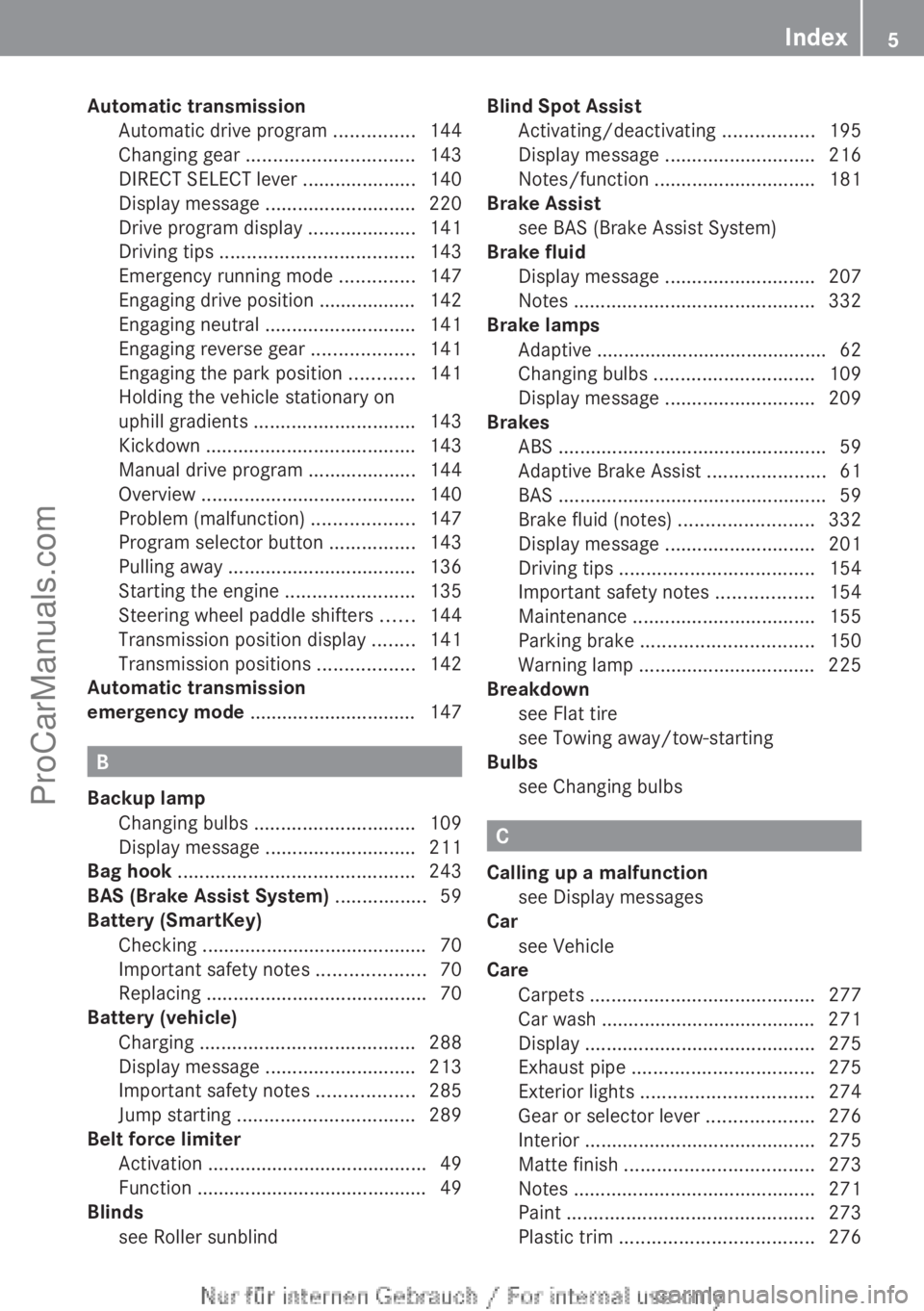
Automatic transmission
Automatic drive program ............... 144
Changing gear ............................... 143
DIRECT SELECT lever .....................140
Display message
............................ 220
Drive program display ....................141
Driving tips .................................... 143
Emergency running mode ..............147
Engaging drive position .................. 142
Engaging neutral ............................ 141
Engaging reverse gear ................... 141
Engaging the park position ............ 141
Holding the vehicle stationary on
uphill gradients .............................. 143
Kickdown ....................................... 143
Manual drive program ....................144
Overview ........................................ 140
Problem (malfunction) ...................147
Program selector button ................143
Pulling away ................................... 136
Starting the engine ........................ 135
Steering wheel paddle shifters ...... 144
Transmission position display ........ 141
Transmission positions .................. 142
Automatic transmission
emergency mode ............................... 147B
Backup lamp Changing bulbs .............................. 109
Display message ............................ 211
Bag hook
............................................ 243
BAS (Brake Assist System) ................. 59
Battery (SmartKey) Checking .......................................... 70
Important safety notes .................... 70
Replacing ......................................... 70
Battery (vehicle)
Charging ........................................ 288
Display message ............................ 213
Important safety notes .................. 285
Jump starting ................................. 289
Belt force limiter
Activation ......................................... 49
Function ........................................... 49
Blinds
see Roller sunblind Blind Spot Assist
Activating/deactivating .................195
Display message
............................ 216
Notes/function .............................. 181
Brake Assist
see BAS (Brake Assist System)
Brake fluid
Display message ............................ 207
Notes ............................................. 332
Brake lamps
Adaptive ........................................... 62
Changing bulbs .............................. 109
Display message ............................ 209
Brakes
ABS .................................................. 59
Adaptive Brake Assist ......................61
BAS .................................................. 59
Brake fluid (notes) .........................332
Display message ............................ 201
Driving tips .................................... 154
Important safety notes .................. 154
Maintenance .................................. 155
Parking brake ................................ 150
Warning lamp ................................. 225
Breakdown
see Flat tire
see Towing away/tow-starting
Bulbs
see Changing bulbs C
Calling up a malfunction see Display messages
Car
see Vehicle
Care
Carpets .......................................... 277
Car wash ........................................ 271
Display ........................................... 275
Exhaust pipe .................................. 275
Exterior lights ................................ 274
Gear or selector lever ....................276
Interior ........................................... 275
Matte finish ................................... 273
Notes ............................................. 271
Paint .............................................. 273
Plastic trim .................................... 276 Index
5
ProCarManuals.com
Page 9 of 340
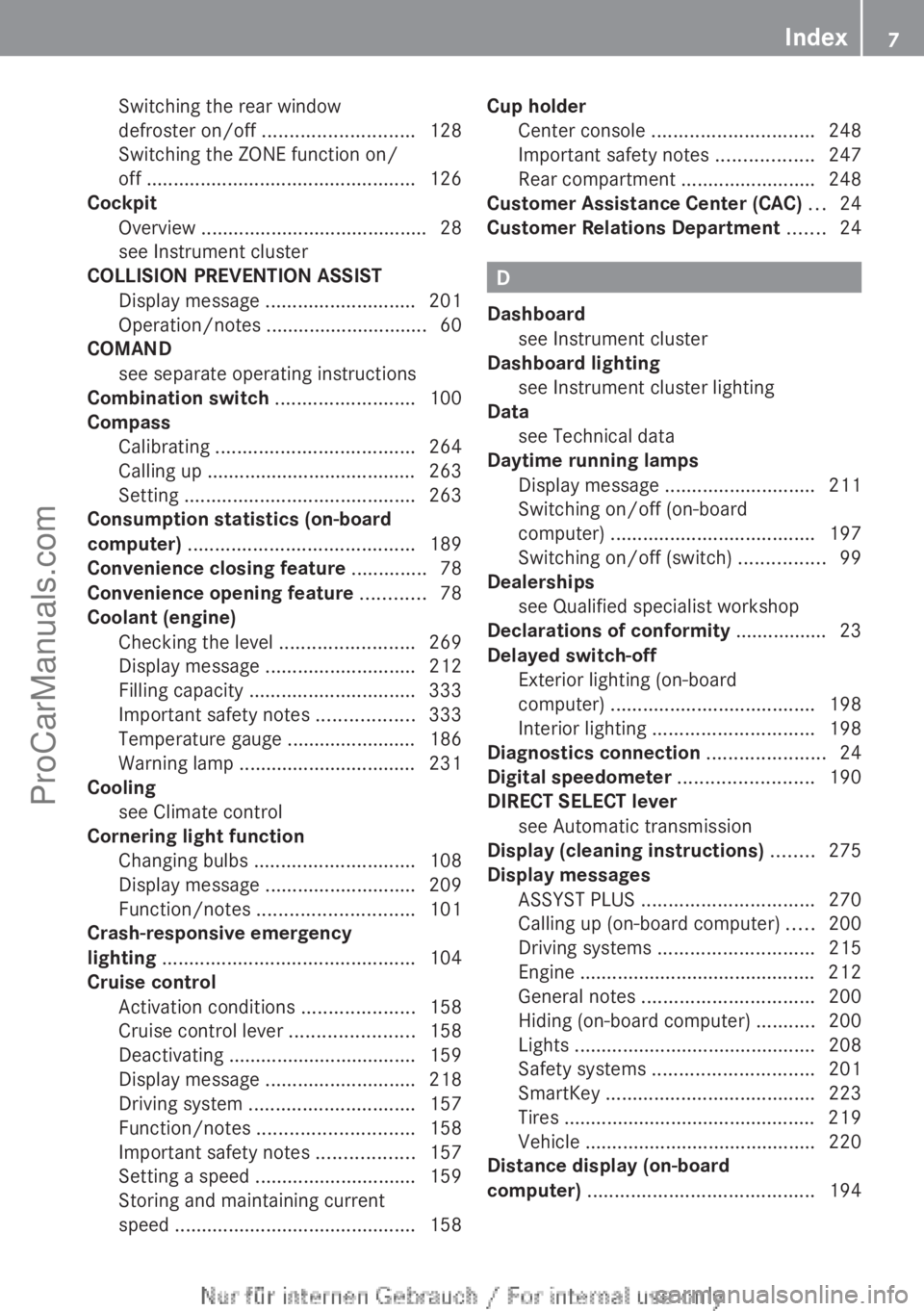
Switching the rear window
defroster on/off
............................ 128
Switching the ZONE function on/
off
.................................................. 126
Cockpit
Overview .......................................... 28
see Instrument cluster
COLLISION PREVENTION ASSIST
Display message ............................ 201
Operation/notes .............................. 60
COMAND
see separate operating instructions
Combination switch ..........................100
Compass Calibrating ..................................... 264
Calling up ....................................... 263
Setting ........................................... 263
Consumption statistics (on-board
computer) .......................................... 189
Convenience closing feature ..............78
Convenience opening feature ............78
Coolant (engine) Checking the level ......................... 269
Display message ............................ 212
Filling capacity ............................... 333
Important safety notes .................. 333
Temperature gauge ........................ 186
Warning lamp ................................. 231
Cooling
see Climate control
Cornering light function
Changing bulbs .............................. 108
Display message ............................ 209
Function/notes ............................. 101
Crash-responsive emergency
lighting ............................................... 104
Cruise control Activation conditions .....................158
Cruise control lever .......................158
Deactivating ................................... 159
Display message ............................ 218
Driving system ............................... 157
Function/notes ............................. 158
Important safety notes .................. 157
Setting a speed .............................. 159
Storing and maintaining current
speed ............................................. 158Cup holder
Center console .............................. 248
Important safety notes ..................247
Rear compartment
.........................248
Customer Assistance Center (CAC) ...24
Customer Relations Department .......24 D
Dashboard see Instrument cluster
Dashboard lighting
see Instrument cluster lighting
Data
see Technical data
Daytime running lamps
Display message ............................ 211
Switching on/off (on-board
computer) ...................................... 197
Switching on/off (switch) ................ 99
Dealerships
see Qualified specialist workshop
Declarations of conformity ................. 23
Delayed switch-off Exterior lighting (on-board
computer) ...................................... 198
Interior lighting .............................. 198
Diagnostics connection ......................24
Digital speedometer .........................190
DIRECT SELECT lever see Automatic transmission
Display (cleaning instructions) ........275
Display messages ASSYST PLUS ................................ 270
Calling up (on-board computer) ..... 200
Driving systems ............................. 215
Engine ............................................ 212
General notes ................................ 200
Hiding (on-board computer) ........... 200
Lights ............................................. 208
Safety systems .............................. 201
SmartKey ....................................... 223
Tires ............................................... 219
Vehicle ........................................... 220
Distance display (on-board
computer) .......................................... 194 Index
7
ProCarManuals.com
Page 11 of 340
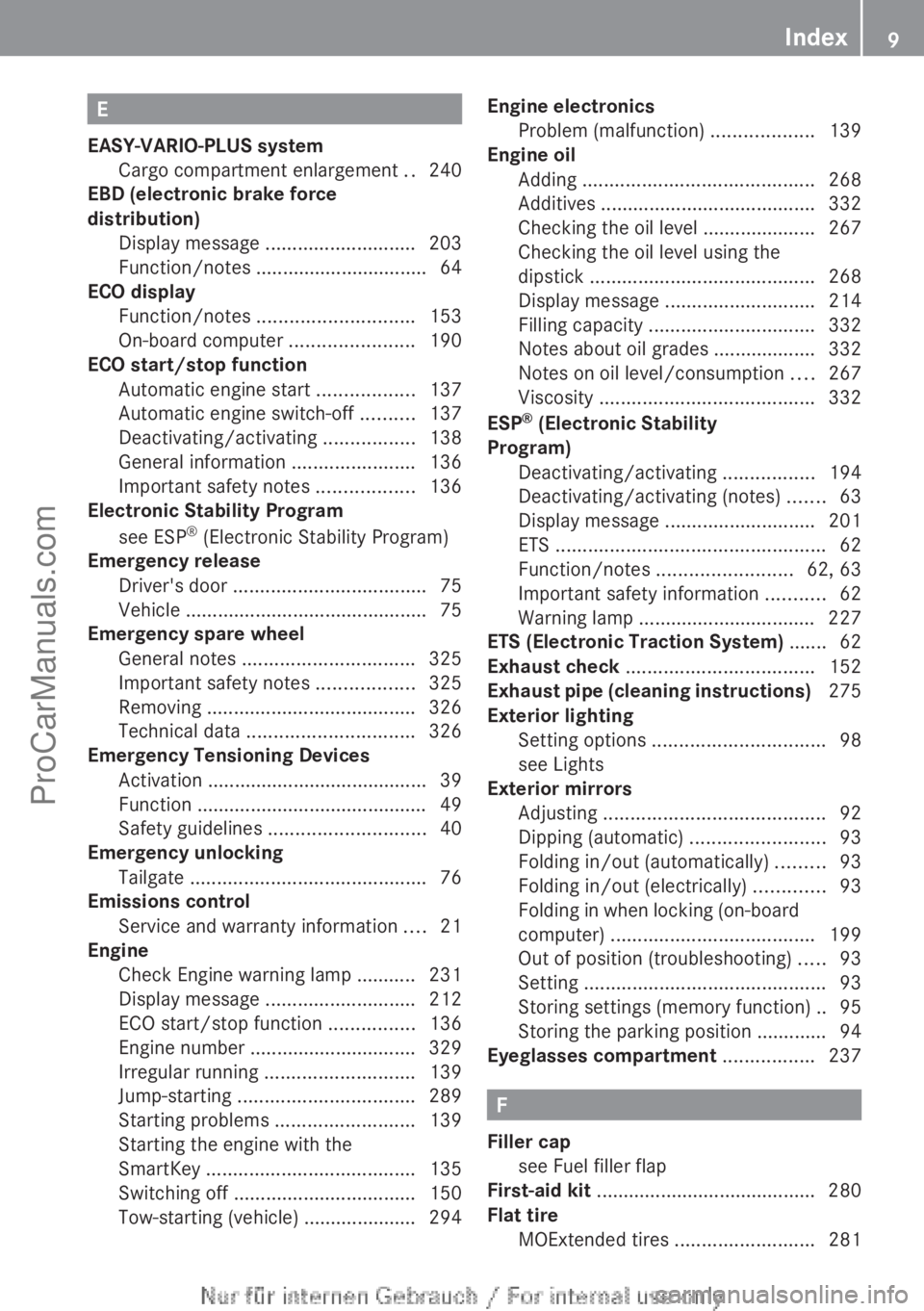
E
EASY-VARIO-PLUS system Cargo compartment enlargement ..240
EBD (electronic brake force
distribution)
Display message ............................ 203
Function/notes ................................
64
ECO display
Function/notes ............................. 153
On-board computer ....................... 190
ECO start/stop function
Automatic engine start .................. 137
Automatic engine switch-off .......... 137
Deactivating/activating ................. 138
General information ....................... 136
Important safety notes .................. 136
Electronic Stability Program
see ESP ®
(Electronic Stability Program)
Emergency release
Driver's door .................................... 75
Vehicle ............................................. 75
Emergency spare wheel
General notes ................................ 325
Important safety notes .................. 325
Removing ....................................... 326
Technical data ............................... 326
Emergency Tensioning Devices
Activation ......................................... 39
Function ........................................... 49
Safety guidelines ............................. 40
Emergency unlocking
Tailgate ............................................ 76
Emissions control
Service and warranty information .... 21
Engine
Check Engine warning lamp ........... 231
Display message ............................ 212
ECO start/stop function ................ 136
Engine number ............................... 329
Irregular running ............................ 139
Jump-starting ................................. 289
Starting problems .......................... 139
Starting the engine with the
SmartKey ....................................... 135
Switching off .................................. 150
Tow-starting (vehicle) ..................... 294 Engine electronics
Problem (malfunction) ...................139
Engine oil
Adding ........................................... 268
Additives ........................................ 332
Checking the oil level ..................... 267
Checking the oil level using the
dipstick
.......................................... 268
Display message ............................ 214
Filling capacity ............................... 332
Notes about oil grades ................... 332
Notes on oil level/consumption .... 267
Viscosity ........................................ 332
ESP ®
(Electronic Stability
Program) Deactivating/activating ................. 194
Deactivating/activating (notes) ....... 63
Display message ............................ 201
ETS .................................................. 62
Function/notes ......................... 62, 63
Important safety information ........... 62
Warning lamp ................................. 227
ETS (Electronic Traction System) ....... 62
Exhaust check ................................... 152
Exhaust pipe (cleaning instructions) 275
Exterior lighting Setting options ................................ 98
see Lights
Exterior mirrors
Adjusting ......................................... 92
Dipping (automatic) .........................93
Folding in/out (automatically) ......... 93
Folding in/out (electrically) ............. 93
Folding in when locking (on-board
computer) ...................................... 199
Out of position (troubleshooting) .....93
Setting ............................................. 93
Storing settings (memory function) .. 95
Storing the parking position ............. 94
Eyeglasses compartment ................. 237 F
Filler cap see Fuel filler flap
First-aid kit ......................................... 280
Flat tire MOExtended tires .......................... 281 Index
9
ProCarManuals.com
Page 41 of 340
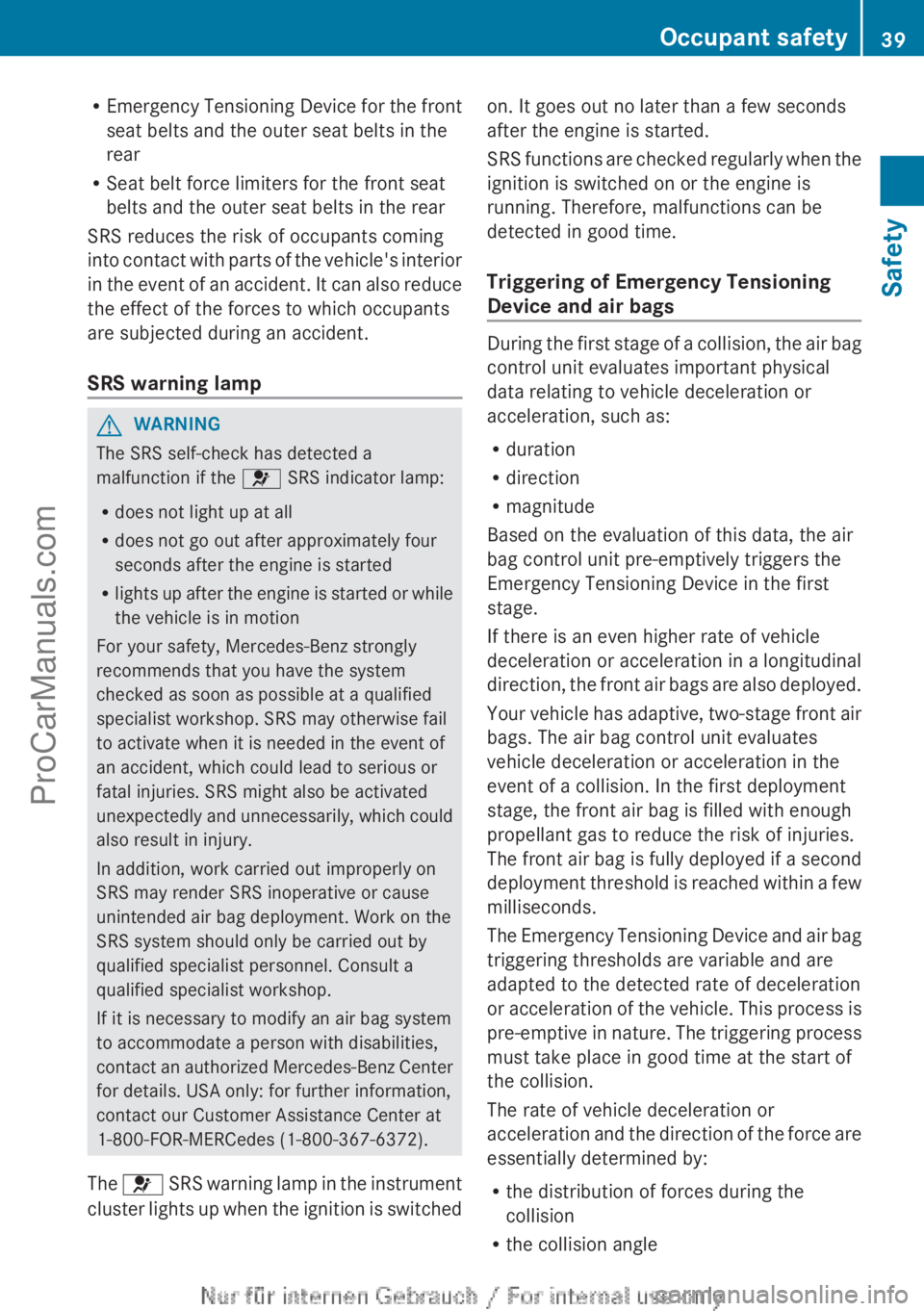
R
Emergency Tensioning Device
for the front
seat belts and the outer seat belts in the
rear
R Seat belt force limiters for the front seat
belts and the outer seat belts in the rear
SRS reduces the risk of occupants coming
into contact with parts of the vehicle's interior
in the event of an accident. It can also reduce
the effect of the forces to which occupants
are subjected during an accident.
SRS warning lamp G
WARNING
The SRS self-check has detected a
malfunction if the 6 SRS indicator lamp:
R does not light up at all
R does not go out after approximately four
seconds after the engine is started
R lights up
after
the engine is started or while
the vehicle is in motion
For your safety, Mercedes-Benz strongly
recommends that you have the system
checked as soon as possible at a qualified
specialist workshop. SRS may otherwise fail
to activate when it is needed in the event of
an accident, which could lead to serious or
fatal injuries. SRS might also be activated
unexpectedly and unnecessarily, which could
also result in injury.
In addition, work carried out improperly on
SRS may render SRS inoperative or cause
unintended air bag deployment. Work on the
SRS system should only be carried out by
qualified specialist personnel. Consult a
qualified specialist workshop.
If it is necessary to modify an air bag system
to accommodate a person with disabilities,
contact an authorized Mercedes-Benz Center
for details. USA only: for further information,
contact our Customer Assistance Center at
1-800-FOR-MERCedes (1-800-367-6372).
The 6 SRS warning lamp in the instrument
cluster lights up when the ignition is switched on. It goes out no later than a few seconds
after the engine is started.
SRS
functions are
checked regularly when the
ignition is switched on or the engine is
running. Therefore, malfunctions can be
detected in good time.
Triggering of Emergency Tensioning
Device and air bags During the first stage of a collision, the air bag
control unit evaluates important physical
data relating to vehicle deceleration or
acceleration, such as:
R
duration
R direction
R magnitude
Based on the evaluation of this data, the air
bag control unit pre-emptively triggers the
Emergency Tensioning Device in the first
stage.
If there is an even higher rate of vehicle
deceleration or acceleration in a longitudinal
direction, the front
air bags are also deployed.
Your vehicle has adaptive, two-stage front air
bags. The air bag control unit evaluates
vehicle deceleration or acceleration in the
event of a collision. In the first deployment
stage, the front air bag is filled with enough
propellant gas to reduce the risk of injuries.
The front air bag is fully deployed if a second
deployment threshold is reached within a few
milliseconds.
The Emergency Tensioning Device and air bag
triggering thresholds are variable and are
adapted to the detected rate of deceleration
or acceleration of the vehicle. This process is
pre-emptive in nature. The triggering process
must take place in good time at the start of
the collision.
The rate of vehicle deceleration or
acceleration and the direction of the force are
essentially determined by:
R the distribution of forces during the
collision
R the collision angle Occupant safety
39
Safety Z
ProCarManuals.com
Page 61 of 340
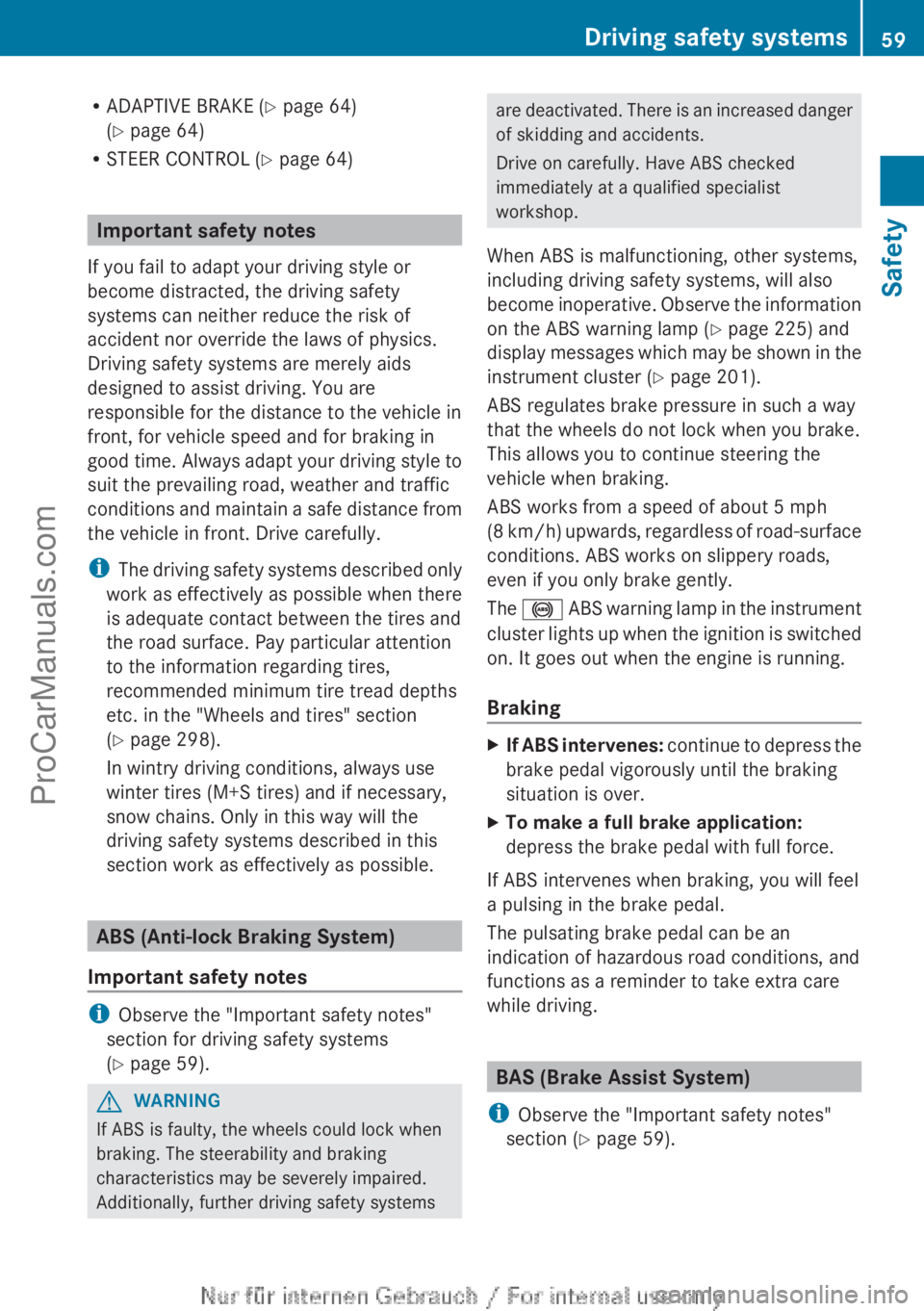
R
ADAPTIVE BRAKE ( Y
page 64)
(Y page 64)
R STEER CONTROL ( Y page 64)Important safety notes
If you fail to adapt your driving style or
become distracted, the driving safety
systems can neither reduce the risk of
accident nor override the laws of physics.
Driving safety systems are merely aids
designed to assist driving. You are
responsible for the distance to the vehicle in
front, for vehicle speed and for braking in
good time. Always
adapt your driving style to
suit the prevailing road, weather and traffic
conditions and maintain a safe distance from
the vehicle in front. Drive carefully.
i The driving safety systems described only
work as effectively as possible when there
is adequate contact between the tires and
the road surface. Pay particular attention
to the information regarding tires,
recommended minimum tire tread depths
etc. in the "Wheels and tires" section
(Y page 298).
In wintry driving conditions, always use
winter tires (M+S tires) and if necessary,
snow chains. Only in this way will the
driving safety systems described in this
section work as effectively as possible. ABS (Anti-lock Braking System)
Important safety notes i
Observe the "Important safety notes"
section for driving safety systems
(Y page 59). G
WARNING
If ABS is faulty, the wheels could lock when
braking. The steerability and braking
characteristics may be severely impaired.
Additionally, further driving safety systems are deactivated. There is an increased danger
of skidding and accidents.
Drive on carefully. Have ABS checked
immediately at a qualified specialist
workshop.
When ABS is malfunctioning, other systems,
including driving safety systems, will also
become inoperative. Observe
the information
on the ABS warning lamp ( Y page 225) and
display messages which may be shown in the
instrument cluster (Y page 201).
ABS regulates brake pressure in such a way
that the wheels do not lock when you brake.
This allows you to continue steering the
vehicle when braking.
ABS works from a speed of about 5 mph
(8 km/h) upwards, regardless of road-surface
conditions. ABS works on slippery roads,
even if you only brake gently.
The ! ABS warning lamp in the instrument
cluster lights up when the ignition is switched
on. It goes out when the engine is running.
Braking X
If ABS intervenes: continue to
depress the
brake pedal vigorously until the braking
situation is over.
X To make a full brake application:
depress the brake pedal with full force.
If ABS intervenes when braking, you will feel
a pulsing in the brake pedal.
The pulsating brake pedal can be an
indication of hazardous road conditions, and
functions as a reminder to take extra care
while driving. BAS (Brake Assist System)
i Observe the "Important safety notes"
section ( Y page 59). Driving safety systems
59
Safety Z
ProCarManuals.com
Page 64 of 340
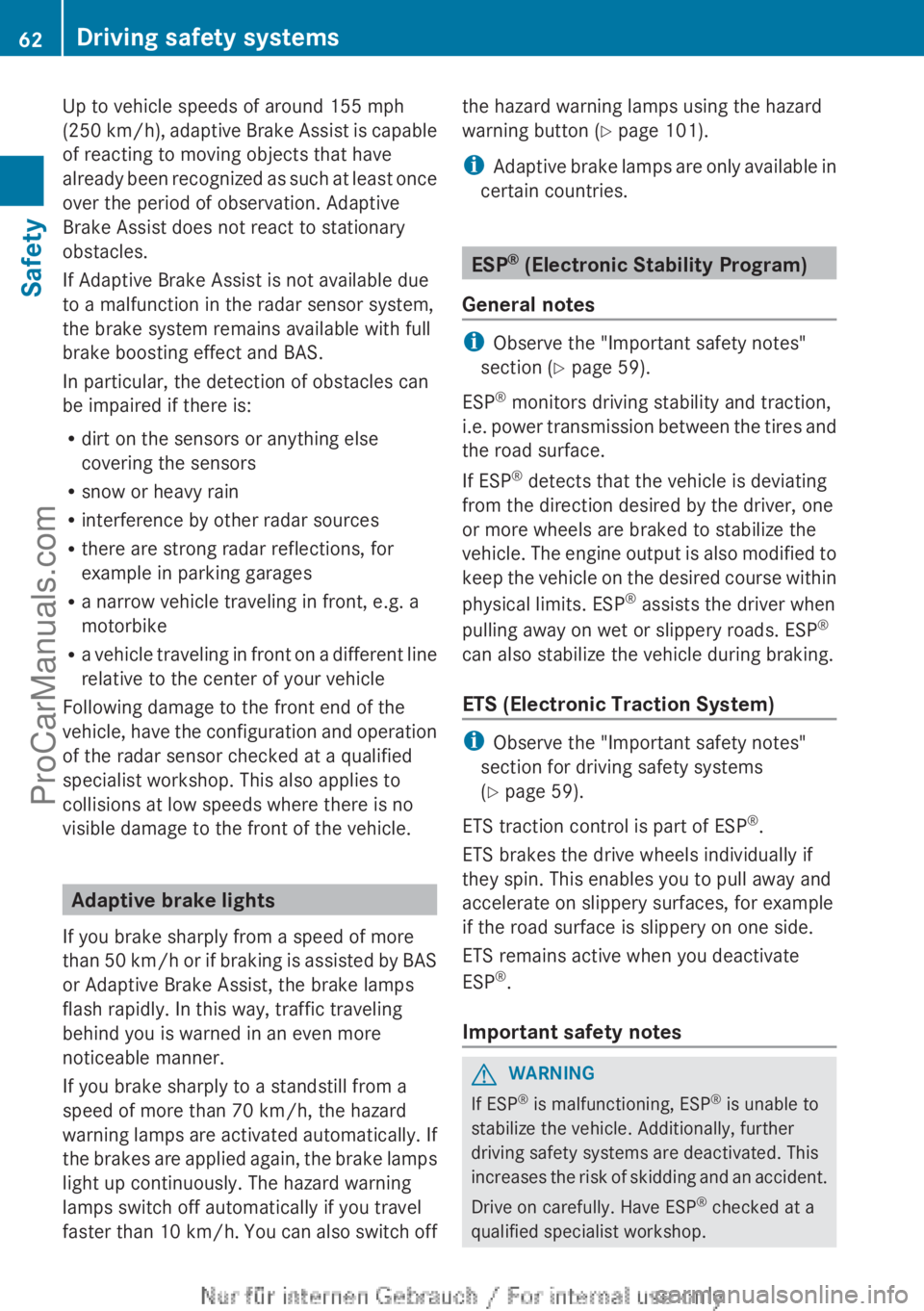
Up to vehicle speeds of around 155 mph
(250 km/h
),
adaptive Brake Assist is capable
of reacting to moving objects that have
already been recognized as such at least once
over the period of observation. Adaptive
Brake Assist does not react to stationary
obstacles.
If Adaptive Brake Assist is not available due
to a malfunction in the radar sensor system,
the brake system remains available with full
brake boosting effect and BAS.
In particular, the detection of obstacles can
be impaired if there is:
R dirt on the sensors or anything else
covering the sensors
R snow or heavy rain
R interference by other radar sources
R there are strong radar reflections, for
example in parking garages
R a narrow vehicle traveling in front, e.g. a
motorbike
R a vehicle traveling in front on a different line
relative to the center of your vehicle
Following damage to the front end of the
vehicle, have the configuration and operation
of the radar sensor checked at a qualified
specialist workshop. This also applies to
collisions at low speeds where there is no
visible damage to the front of the vehicle. Adaptive brake lights
If you brake sharply from a speed of more
than 50 km/h
or if braking is assisted by BAS
or Adaptive Brake Assist, the brake lamps
flash rapidly. In this way, traffic traveling
behind you is warned in an even more
noticeable manner.
If you brake sharply to a standstill from a
speed of more than 70 km/h, the hazard
warning lamps are activated automatically. If
the brakes are applied again, the brake lamps
light up continuously. The hazard warning
lamps switch off automatically if you travel
faster than 10 km/h. You can also switch off the hazard warning lamps using the hazard
warning button (Y page 101).
i
Adaptive brake lamps
are only available in
certain countries. ESP
®
(Electronic Stability Program)
General notes i
Observe the "Important safety notes"
section ( Y page 59).
ESP ®
monitors driving stability and traction,
i.e. power transmission
between the tires and
the road surface.
If ESP ®
detects that the vehicle is deviating
from the direction desired by the driver, one
or more wheels are braked to stabilize the
vehicle. The engine output is also modified to
keep the vehicle on the desired course within
physical limits. ESP ®
assists the driver when
pulling away on wet or slippery roads. ESP ®
can also stabilize the vehicle during braking.
ETS (Electronic Traction System) i
Observe the "Important safety notes"
section for driving safety systems
(Y page 59).
ETS traction control is part of ESP ®
.
ETS brakes the drive wheels individually if
they spin. This enables you to pull away and
accelerate on slippery surfaces, for example
if the road surface is slippery on one side.
ETS remains active when you deactivate
ESP ®
.
Important safety notes G
WARNING
If ESP ®
is malfunctioning, ESP ®
is unable to
stabilize the vehicle. Additionally, further
driving safety systems are deactivated. This
increases the risk
of skidding and an accident.
Drive on carefully. Have ESP ®
checked at a
qualified specialist workshop. 62
Driving safety systems
Safety
ProCarManuals.com
Page 75 of 340
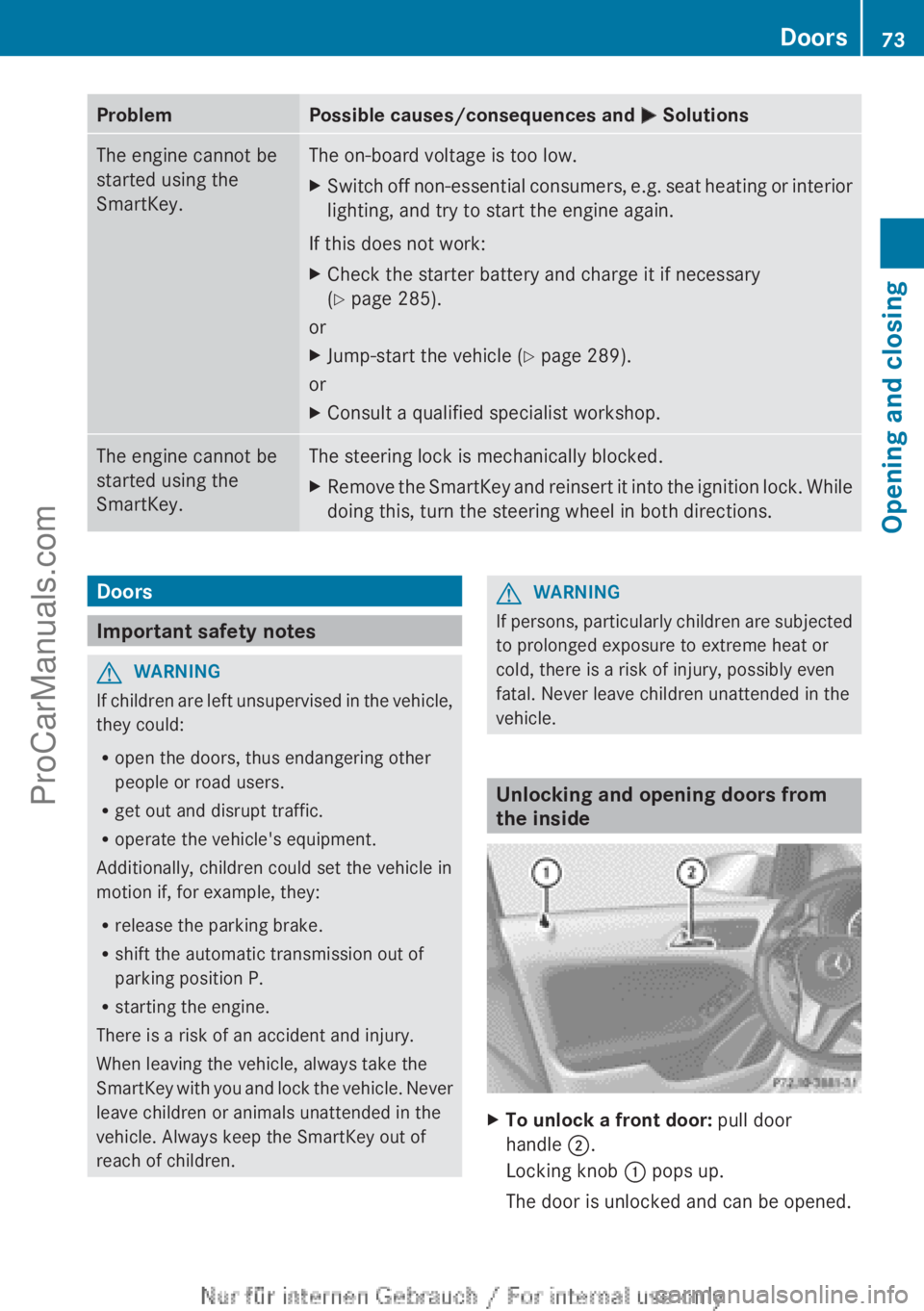
Problem Possible causes/consequences and
M SolutionsThe engine cannot be
started using the
SmartKey. The on-board voltage is too low.
X
Switch off non-essential consumers, e.g. seat heating or interior
lighting, and try to start the engine again.
If this does not work:
X Check the starter battery and charge it if necessary
(Y page 285).
or
X Jump-start the vehicle (Y page 289).
or
X Consult a qualified specialist workshop. The engine cannot be
started using the
SmartKey. The steering lock is mechanically blocked.
X
Remove the SmartKey and reinsert it into the ignition lock. While
doing this, turn the steering wheel in both directions. Doors
Important safety notes
G
WARNING
If children are left unsupervised in the vehicle,
they could:
R open the doors, thus endangering other
people or road users.
R get out and disrupt traffic.
R operate the vehicle's equipment.
Additionally, children could set the vehicle in
motion if, for example, they:
R release the parking brake.
R shift the automatic transmission out of
parking position P.
R starting the engine.
There is a risk of an accident and injury.
When leaving the vehicle, always take the
SmartKey with you
and lock the vehicle. Never
leave children or animals unattended in the
vehicle. Always keep the SmartKey out of
reach of children. G
WARNING
If persons, particularly children are subjected
to prolonged exposure to extreme heat or
cold, there is a risk of injury, possibly even
fatal. Never leave children unattended in the
vehicle. Unlocking and opening doors from
the inside
X
To unlock a front door: pull door
handle ;.
Locking knob : pops up.
The door is unlocked and can be opened. Doors
73
Opening and closing Z
ProCarManuals.com
Page 107 of 340
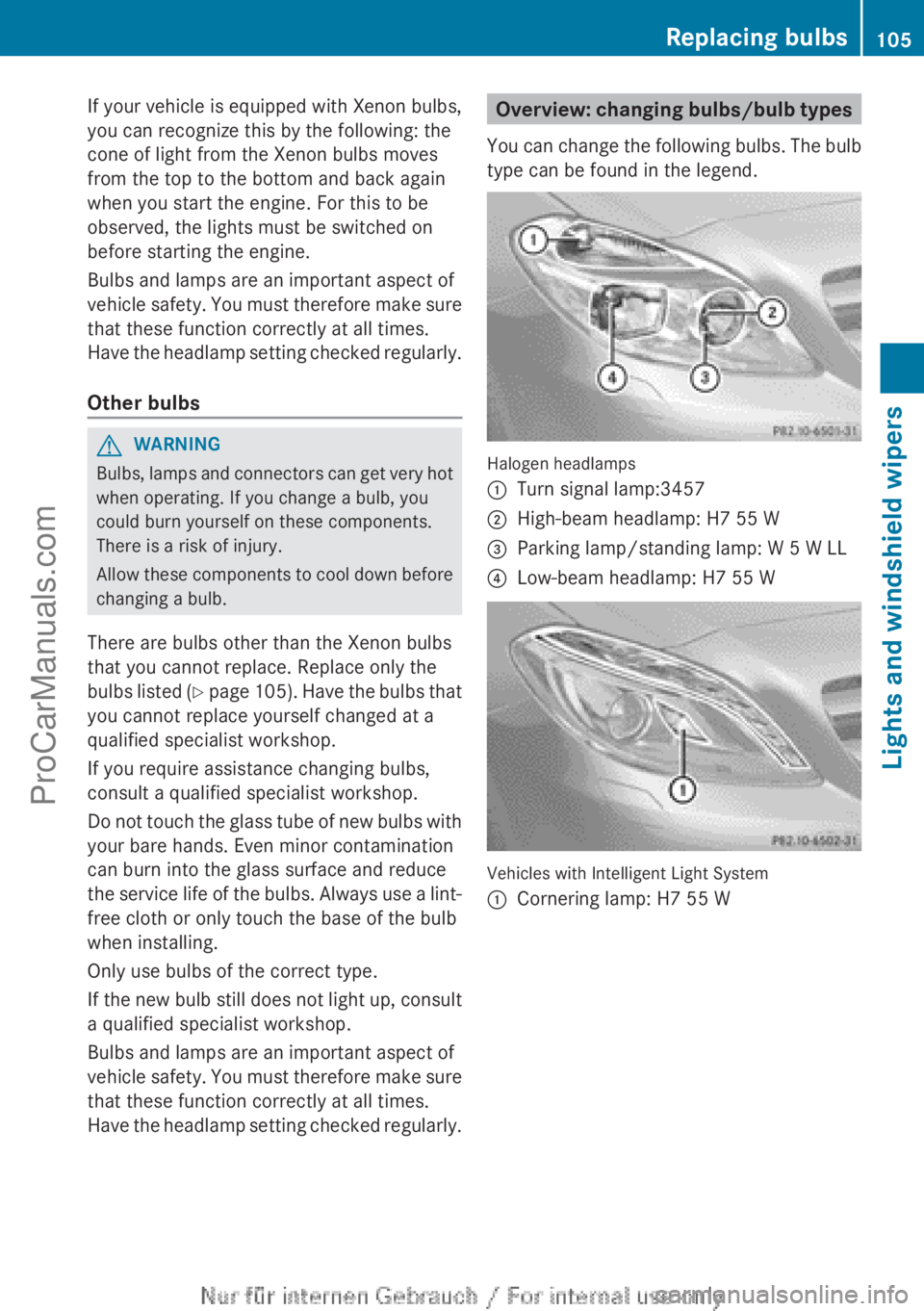
If your vehicle is equipped with Xenon bulbs,
you can recognize this by the following: the
cone of light from the Xenon bulbs moves
from the top to the bottom and back again
when you start the engine. For this to be
observed, the lights must be switched on
before starting the engine.
Bulbs and lamps are an important aspect of
vehicle safety.
You
must therefore make sure
that these function correctly at all times.
Have the headlamp setting checked regularly.
Other bulbs G
WARNING
Bulbs, lamps and connectors can get very hot
when operating. If you change a bulb, you
could burn yourself on these components.
There is a risk of injury.
Allow these components
to cool down before
changing a bulb.
There are bulbs other than the Xenon bulbs
that you cannot replace. Replace only the
bulbs listed (Y page 105). Have the bulbs that
you cannot replace yourself changed at a
qualified specialist workshop.
If you require assistance changing bulbs,
consult a qualified specialist workshop.
Do not touch the glass tube of new bulbs with
your bare hands. Even minor contamination
can burn into the glass surface and reduce
the service life of the bulbs. Always use a lint-
free cloth or only touch the base of the bulb
when installing.
Only use bulbs of the correct type.
If the new bulb still does not light up, consult
a qualified specialist workshop.
Bulbs and lamps are an important aspect of
vehicle safety. You must therefore make sure
that these function correctly at all times.
Have the headlamp setting checked regularly. Overview: changing bulbs/bulb types
You can change
the following bulbs. The bulb
type can be found in the legend. Halogen headlamps
:
Turn signal lamp:3457
; High-beam headlamp: H7 55 W
= Parking lamp/standing lamp: W 5 W LL
? Low-beam headlamp: H7 55 W Vehicles with Intelligent Light System
:
Cornering lamp: H7 55 W Replacing bulbs
105
Lights and windshield wipers Z
ProCarManuals.com
Page 142 of 340
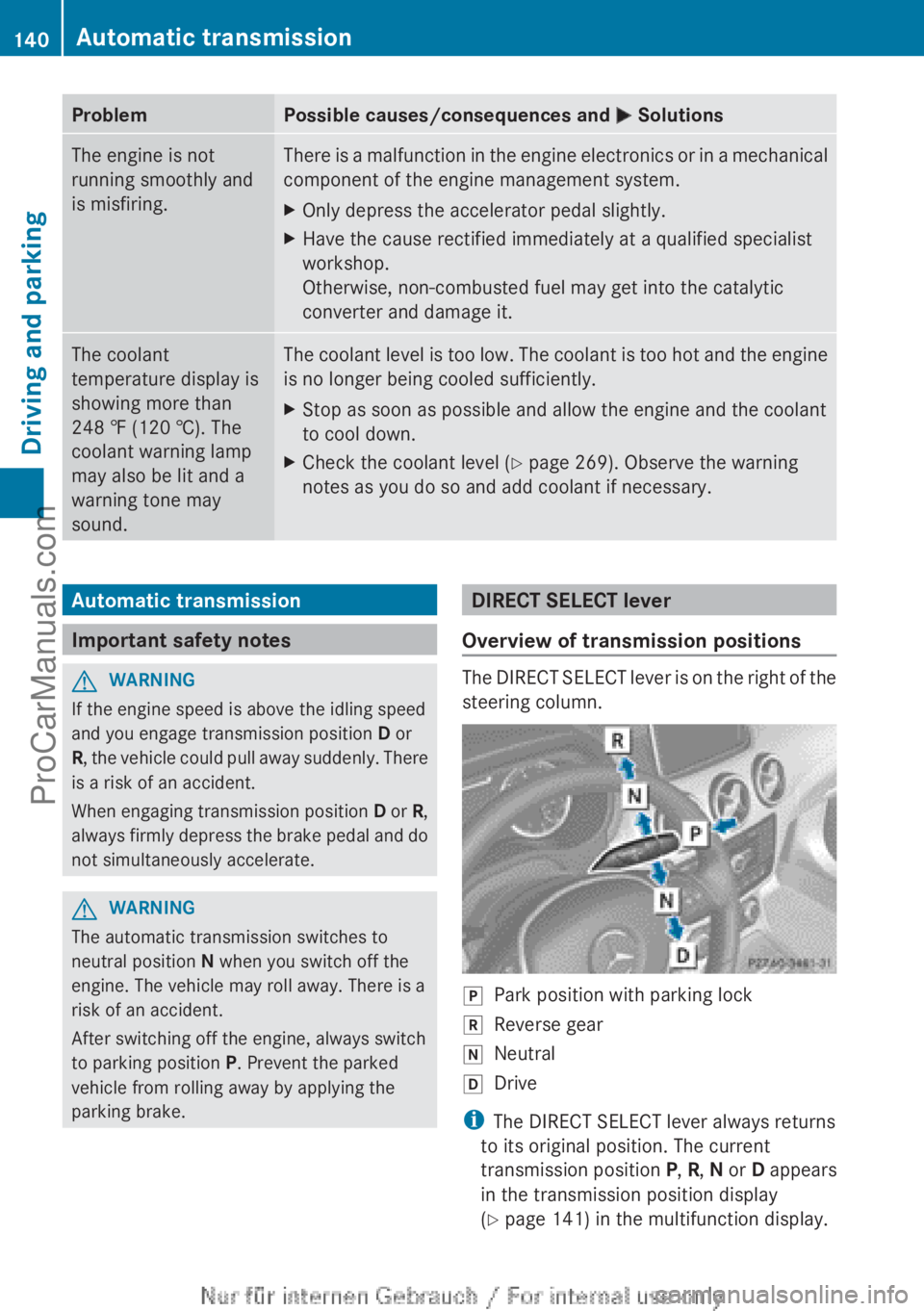
Problem Possible causes/consequences and
M SolutionsThe engine is not
running smoothly and
is misfiring. There is a malfunction in the engine electronics or in a mechanical
component of the engine management system.
X
Only depress the accelerator pedal slightly.
X Have the cause rectified immediately at a qualified specialist
workshop.
Otherwise, non-combusted fuel may get into the catalytic
converter and damage it. The coolant
temperature display is
showing more than
248 ‡
(120 †). The
coolant warning lamp
may also be lit and a
warning tone may
sound. The coolant level is too low. The coolant is too hot and the engine
is no longer being cooled sufficiently.
X
Stop as soon as possible and allow the engine and the coolant
to cool down.
X Check the coolant level (Y page 269). Observe the warning
notes as you do so and add coolant if necessary. Automatic transmission
Important safety notes
G
WARNING
If the engine speed is above the idling speed
and you engage transmission position D or
R, the vehicle
could pull away suddenly. There
is a risk of an accident.
When engaging transmission position D or R,
always firmly depress the brake pedal and do
not simultaneously accelerate. G
WARNING
The automatic transmission switches to
neutral position N when you switch off the
engine. The vehicle may roll away. There is a
risk of an accident.
After switching off the engine, always switch
to parking position P. Prevent the parked
vehicle from rolling away by applying the
parking brake. DIRECT SELECT lever
Overview of transmission positions The DIRECT SELECT lever is on the right of the
steering column.
j
Park position with parking lock
k Reverse gear
i Neutral
h Drive
i The DIRECT SELECT lever always returns
to its original position. The current
transmission position
P, R
, N or D appears
in the transmission position display
(Y page 141) in the multifunction display. 140
Automatic transmission
Driving and parking
ProCarManuals.com
Page 150 of 340
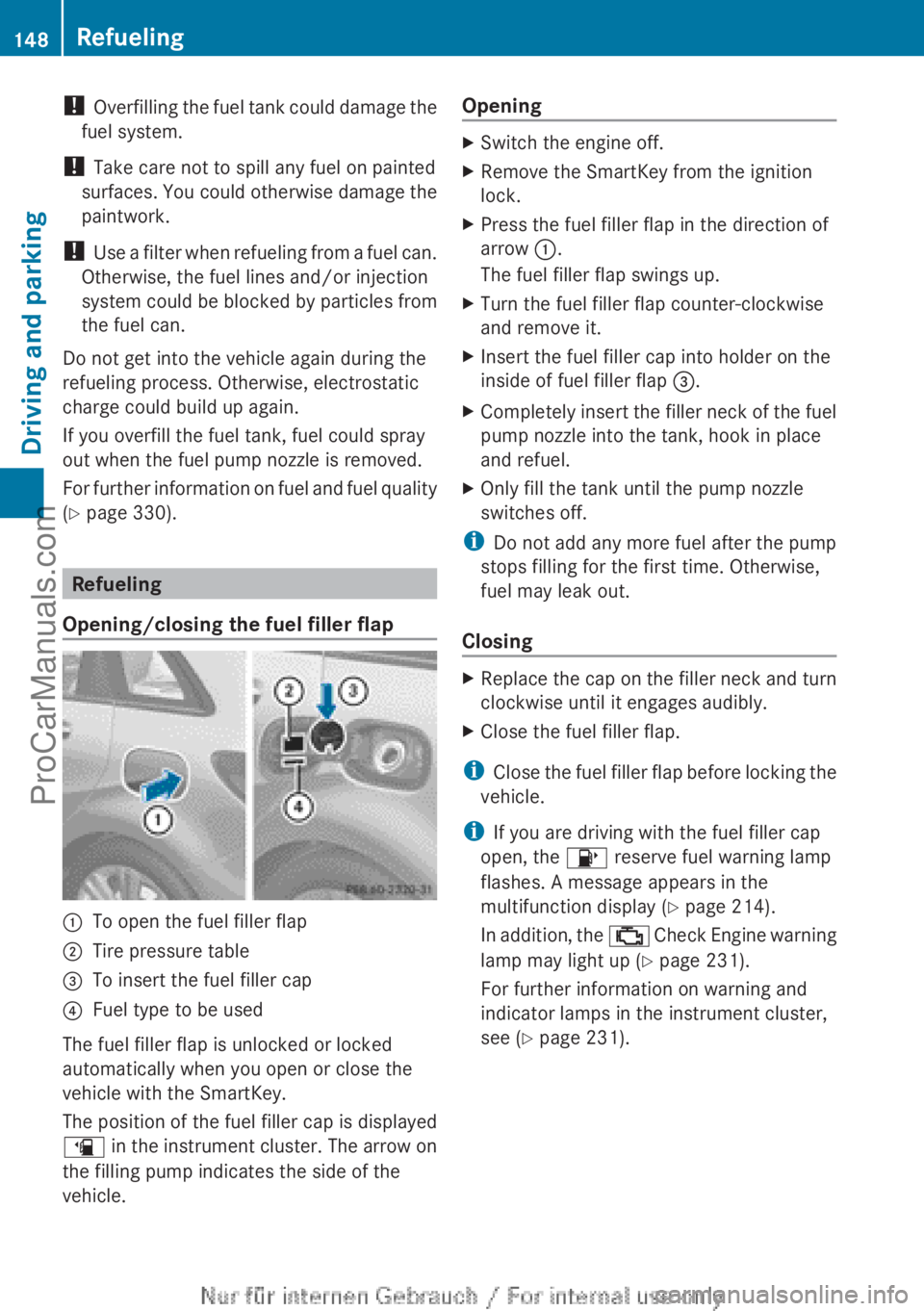
!
Overfilling the fuel
tank could damage the
fuel system.
! Take care not to spill any fuel on painted
surfaces. You could otherwise damage the
paintwork.
! Use a filter when refueling from a fuel can.
Otherwise, the fuel lines and/or injection
system could be blocked by particles from
the fuel can.
Do not get into the vehicle again during the
refueling process. Otherwise, electrostatic
charge could build up again.
If you overfill the fuel tank, fuel could spray
out when the fuel pump nozzle is removed.
For further information on fuel and fuel quality
(Y page 330). Refueling
Opening/closing the fuel filler flap :
To open the fuel filler flap
; Tire pressure table
= To insert the fuel filler cap
? Fuel type to be used
The fuel filler flap is unlocked or locked
automatically when you open or close the
vehicle with the SmartKey.
The position of the fuel filler cap is displayed
æ in
the
instrument cluster. The arrow on
the filling pump indicates the side of the
vehicle. Opening X
Switch the engine off.
X Remove the SmartKey from the ignition
lock.
X Press the fuel filler flap in the direction of
arrow :.
The fuel filler flap swings up.
X Turn the fuel filler flap counter-clockwise
and remove it.
X Insert the fuel filler cap into holder on the
inside of fuel filler flap =.
X Completely insert the filler neck of the fuel
pump nozzle into the tank, hook in place
and refuel.
X Only fill the tank until the pump nozzle
switches off.
i Do not add any more fuel after the pump
stops filling for the first time. Otherwise,
fuel may leak out.
Closing X
Replace the cap on the filler neck and turn
clockwise until it engages audibly.
X Close the fuel filler flap.
i Close the fuel
filler flap before locking the
vehicle.
i If you are driving with the fuel filler cap
open, the 8 reserve fuel warning lamp
flashes. A message appears in the
multifunction display ( Y page 214).
In addition, the ; Check Engine warning
lamp may light up ( Y page 231).
For further information on warning and
indicator lamps in the instrument cluster,
see ( Y page 231).148
Refueling
Driving and parking
ProCarManuals.com